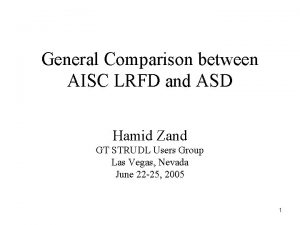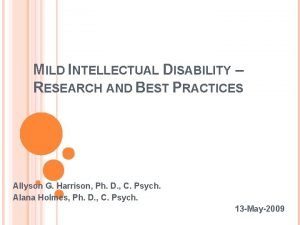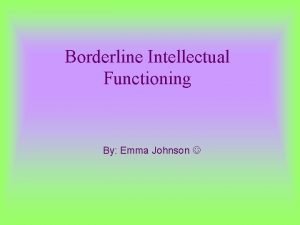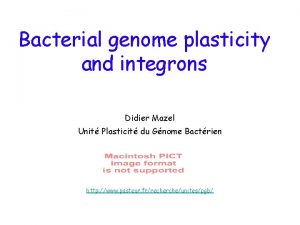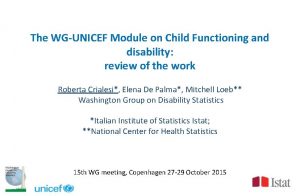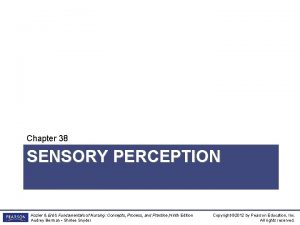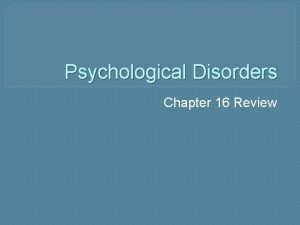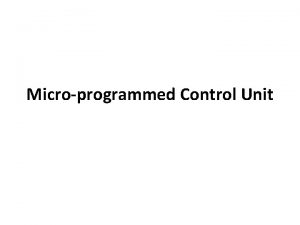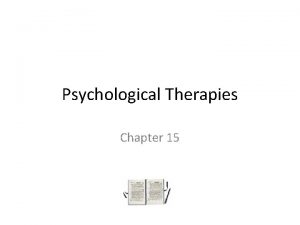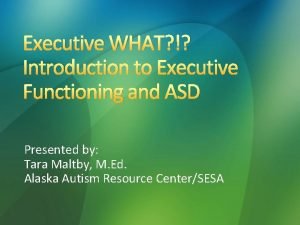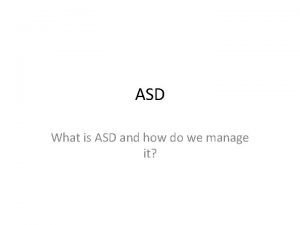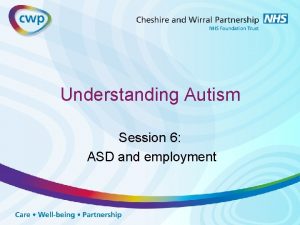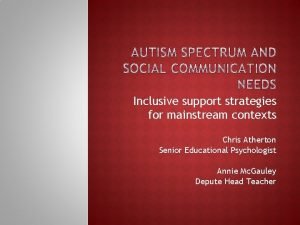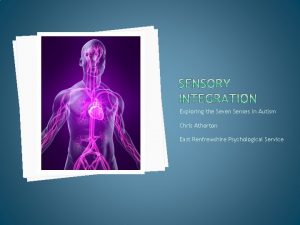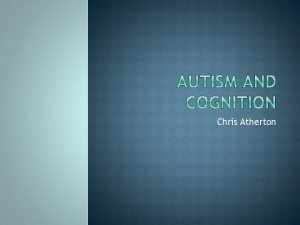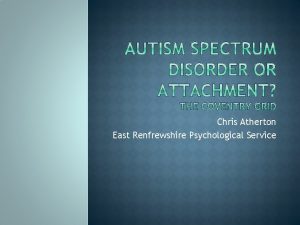ASD Executive Functioning Chris Atherton Cognitive Theories and
















- Slides: 16

ASD & Executive Functioning Chris Atherton

Cognitive Theories and ASD n Theory of Mind (Happé, 1994) n Central Coherence (Frith, 1989, 1994) n Executive Function (Hill, 2004) n Extreme Male Brain (Baron-Cohen, 2003)

What is Executive Function? An overarching term that refers to mental control processes that enable physical, cognitive, and emotional self-control (Denckla, 1996; Lezak, 1995, Pennington & Ozonoff, 1996). n Higher order control processes necessary to guide behaviour in a constantly changing environment (Jurado & Rosselli, 2007; Robinson & Goddard et. Al, 2009). n Planning, working memory, mental flexibility, response initiation, response inhibition, impulse control and monitoring of action (Roberts, Robbins, & Weiskrantz, 1998; Stuss & Knight, 2002). n

What is Executive Function? n “‘Executive function’ is an umbrella term for functions such as planning, working memory, impulse control, inhibition and mental flexibility, as well as for the initiation and monitoring of action. ” Hill, 2004

Neurological Basis Behavioural and neuropsychological studies originally linked executive functions to the frontal lobes, in particular the pre-frontal cortex (Baddeley & Wilson, 1988; Stuss & Benson, 1986). n Executive functions more recently associated with different regions of the frontal lobes, with links between frontal and posterior areas, as well as sub-cortical and thalamic pathways (Monchi, Petrides, Strafella, Worsley, & Doyon, 2006; Stuss & Alexander, 2000; Stuss et al. , 2002). n

Executive Function Impairment n n n n Acquired brain injury to the frontal lobe Attention deficit hyperactivity disorder (ADHD) Obsessive compulsive disorder Tourette syndrome Phenylketonuria (PKU) Schizophrenia Autism spectrum disorder Acquired brain injury to non-frontal brain areas Hill 2004


Stroop Test n http: //www. youtube. com/watch? v=Tpge 6 c 3 Ic 4 g

Why are EF processes important? n Effective goal-directed behaviour (Welsh, 1988) n Effective response inhibition, working memory, cognitive flexibility (set shifting), planning and fluency (Ozonoff & Strayer, 1997; Pennington & Ozonoff, 1996)

ASD and EF n EF deficits consistently found in ASD population and other development disorders (Russell, 1997; Corbett & Constantine et. al, 2009) n Patients with frontal lobe lesions found to demonstrate similar characteristics to those found in the ASD population (Ozonoff, Pennington and Rogers, 1991).

EF Theory and ASD Behaviour n Need for sameness n Repetitive behaviours n Lack of impulse control n Difficulty initiating new routine actions n Difficulty switching between tasks (Hill, 2004; Rajendran & Mitchell, 2007)

EF and ASD Behaviour n Strengths and weaknesses in these behaviours for individuals with ASD n Not successfully explained by: – theory of mind deficit (Happé, 1994) – weak central coherence (Frith, 1989, 2003) – extreme male brain theory (Baron-Cohen, 2002).

Corbett and Constantine (2009) n Compared and contrasted six domains of EF in children with ASD, ADHD and typical development: – response inhibition, working memory, flexibility/shifting, planning, fluency and vigilance n Children with ASD: n Acknowledged co-morbidity of symptoms in ASD and ADHD populations as limitation on these key findings. – demonstrate pervasive impairment across a broad range of EF tasks. – showed poor performance relative to the typical group in inhibition, working memory, flexibility/shifting and vigilance. – performed more poorly than the ADHD group in regards to inhibition, working memory, and flexibility. – There were no significant differences observed on measures of planning and fluency across the groups.

Classroom Implications Self Regulatory Skills – Perception, Modulation, Sustained Attention, Flexibility, Working Memory, Response Inhibition, Emotional Regulation. n Goal Oriented Skills – Planning, Organisation, Time Management, Self Monitoring. n n Mc. Dougall (2001) Executive functions: Practical strategies for supporting students. Psychological Services, DDSB. Symposium conducted at DDSB, Ontario, Canada.

Comment on NAS Website ‘TUNNEL THINKING’ n ‘The rabbit hole's of our mind do not all lead to Alice in Wonderland or the Mad Hatters Tea Party but we are the custodians of rarity and it is not beyond the bounds of our own perception to be healthy mentally, be cautious when drinking the potions on offer in the windows of neurotypical shop sellers, they are after all for them not necessarily for us and looking around they are none too healthy or happy drinking their own potions. ’ n

n “It is concluded that more detailed research is needed to fractionate the executive system in autism by assessing a wide range of executive functions as well as their neuroanatomical correlates in the same individuals across the lifespan. ” Hill, 2004
 Cognitive and non cognitive religious language
Cognitive and non cognitive religious language Aisc
Aisc What is child functioning module
What is child functioning module Accommodations for borderline intellectual functioning
Accommodations for borderline intellectual functioning Adaptive functioning
Adaptive functioning Borderline intellectual functioning
Borderline intellectual functioning Adaptive functioning
Adaptive functioning What are signs of high functioning autism
What are signs of high functioning autism What is child functioning module
What is child functioning module Sensory functioning fundamentals of nursing
Sensory functioning fundamentals of nursing Is a reaction to vague or imagined dangers
Is a reaction to vague or imagined dangers Functioning of micro programmed control unit
Functioning of micro programmed control unit Phrasal verb stop working
Phrasal verb stop working Working of autoclave
Working of autoclave Advantages of group therapy
Advantages of group therapy Six domains of the family functioning assessment
Six domains of the family functioning assessment What is stimming
What is stimming

